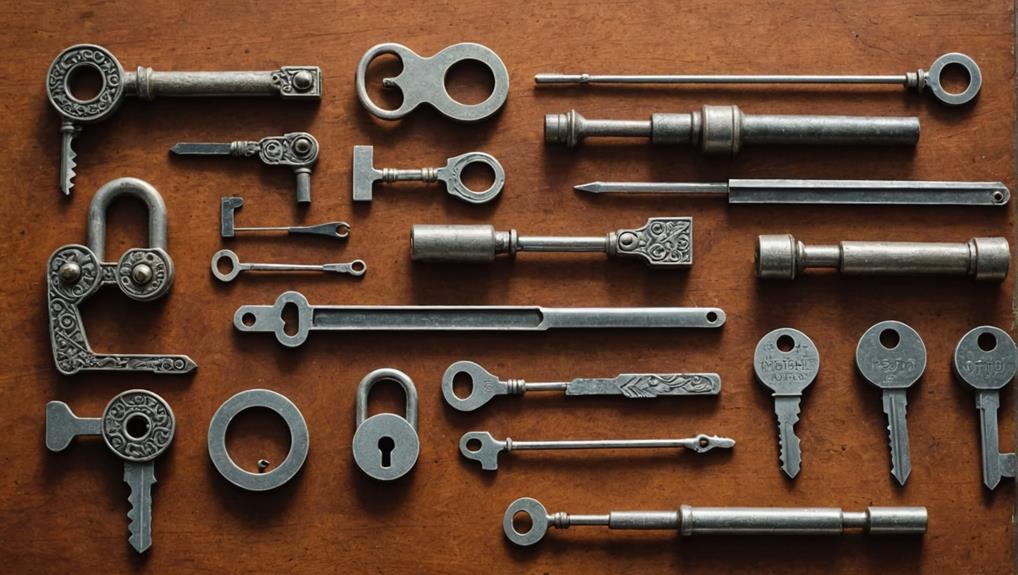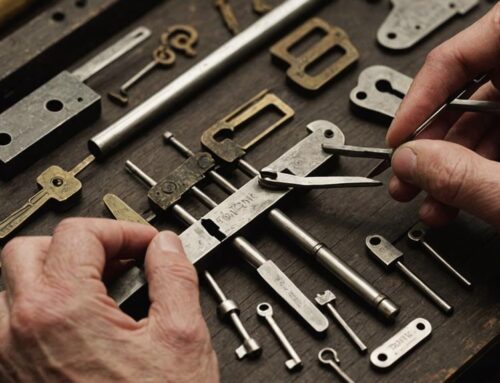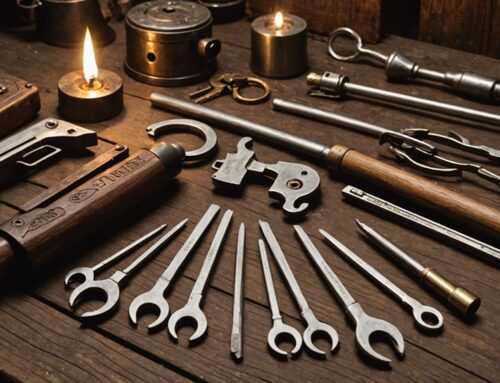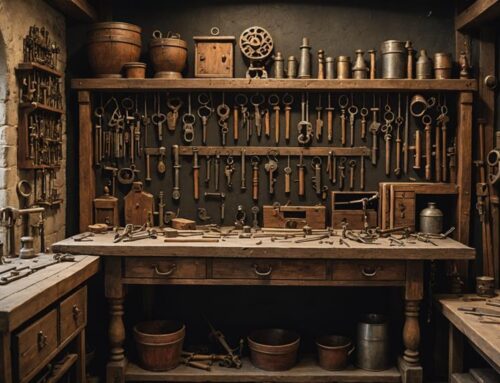Lock picking has evolved over time due to the intricate advancements in lock mechanisms. From ancient times with wooden and metal locks to complex medieval designs, the need for security has spurred progress. The Industrial Revolution and World Wars pushed for stronger locks, leading to modern electronic and smart lock systems. Lock pickers have adapted to match the evolving technology, utilizing new tools and techniques. The rise of lock sport communities and the influence of cybersecurity have further shaped the art of lock picking. Explore how historical events and technological innovations have influenced the development of lock picking techniques.
Key Takeaways
- Lock picking evolution reflects advancements in lock craftsmanship over centuries.
- Industrial revolution spurred standardized manufacturing processes impacting lock security.
- Technological advancements led to complex lock mechanisms for enhanced security.
- World Wars heightened the need for sophisticated locking systems for military and espionage purposes.
- Rise of lock sport communities fosters knowledge sharing and skill development among enthusiasts.
Ancient Lock Mechanisms
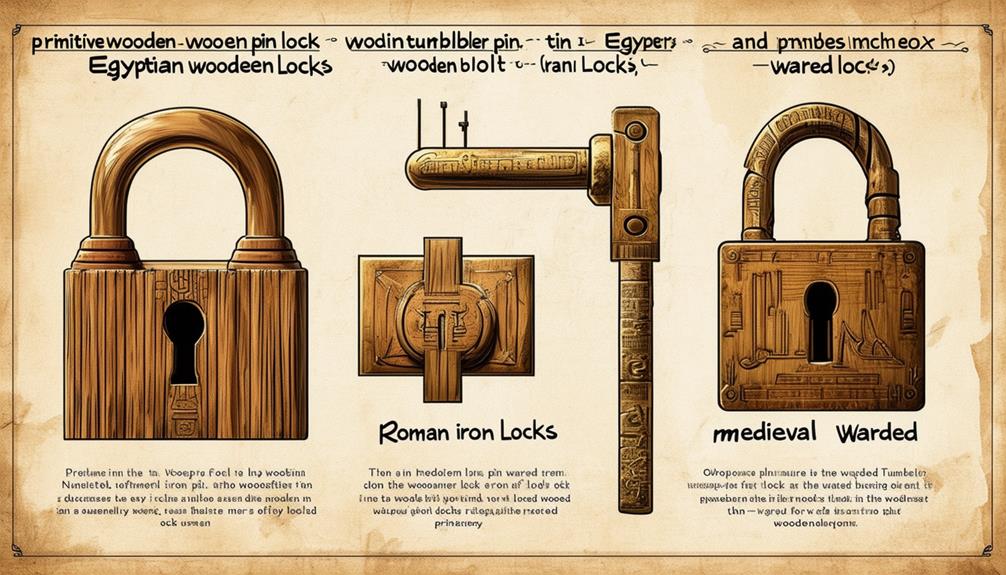
Ancient lock mechanisms date back centuries, showcasing the ingenuity of early civilizations in securing their valuables. These early locks were often simple in design yet effective in their purpose.
The historical influence on lock picking can be traced back to the clever methods employed by ancient locksmiths to create these security devices. Techniques such as early lock designs highlight the innovations that laid the groundwork for future advancements in security.
Early locks were crafted using materials such as wood, metal, and even rope. They featured mechanisms like pins, tumblers, and wards that required intricate knowledge to manipulate.
Despite their basic construction, these locks were essential in safeguarding treasures and important documents.
The advancement of ancient lock mechanisms had a significant impact on the development of lock picking techniques. As civilizations evolved, so did the complexity of locks, leading to the emergence of more sophisticated methods of bypassing them.
Understanding the historical progression of lock mechanisms provides valuable insight into the evolution of lock picking as a skill.
Medieval Locksmithing Techniques
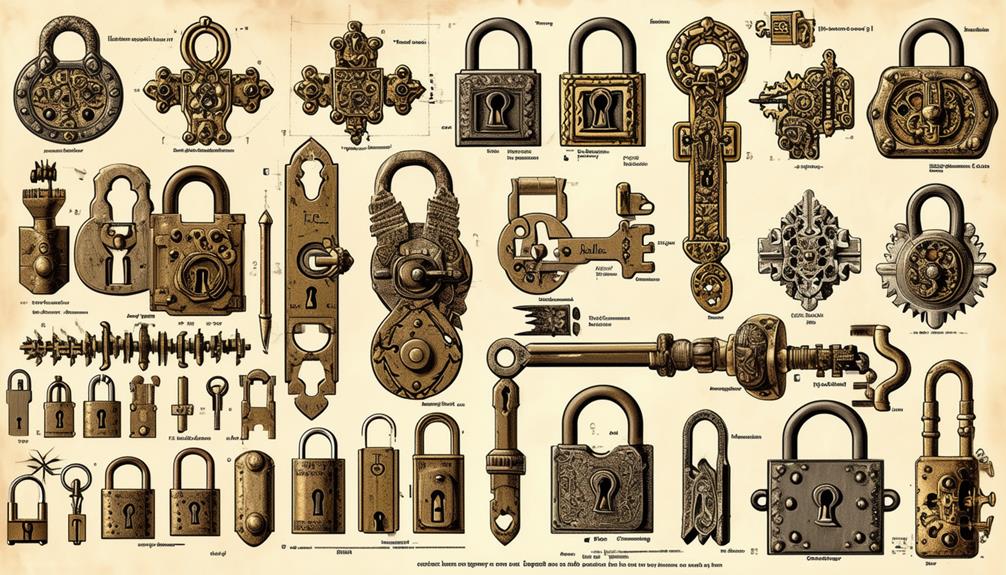
Now it's time to shift our focus to Medieval Locksmithing Techniques.
During this period, locksmiths continued to refine their craftsmanship in creating intricate locking mechanisms with heightened security features.
These advancements included the use of unique tools, such as warding files and various picks, which allowed for more complex lock designs.
Exploring the evolution of these techniques sheds light on the ingenious ways in which people safeguarded their valuables centuries ago, revealing the importance of medieval locksmith tools in enhancing security.
Ancient Lock Mechanisms
Medieval locksmithing techniques were characterized by intricate designs and clever mechanisms that safeguarded valuable properties. Ancient lock mechanisms, crafted during the medieval period, played a significant role in securing belongings.
These locks featured a variety of innovative components, such as wards, levers, and pins, which required specific keys to manipulate them effectively. The evolution of lock picking can be traced back to the challenges posed by these sophisticated mechanisms.
Locksmiths of the time honed their skills to create intricate locks that weren't easily tampered with. The designs were often influenced by the need for heightened security, leading to the development of complex locking systems.
Understanding these ancient lock mechanisms provides insight into the craftsmanship and ingenuity of medieval locksmiths. By studying these historical techniques, modern locksmiths and enthusiasts gain a deeper appreciation for the evolution of lock picking and the advancements in security systems over time.
Craftsmanship in Locks
Craftsmanship in locks during the medieval period showcased intricate designs and innovative mechanisms that reflected the skill and creativity of locksmiths.
The history of lock picking reveals the evolution of lock mechanisms from simple designs to more sophisticated and secure systems. Medieval locksmiths crafted locks with precision, using techniques that varied depending on the region and available materials. Intricate patterns and ornate details were often incorporated into lock designs to not only enhance security but also showcase the artisan's skill.
Lock mechanisms during this period often featured multiple moving parts, such as tumblers and wards, which required precise alignment to open the lock successfully.
Locksmiths employed techniques like warding, where internal obstacles hindered unauthorized access, and lever mechanisms that required specific key shapes to operate. These innovations not only provided security but also challenged lock pickers to develop their skills in bypassing these complex mechanisms.
Industrial Revolution Impact

During the Industrial Revolution, the evolution of lock picking techniques was greatly influenced by the advancements in manufacturing processes and technology. As industries flourished and production methods became more sophisticated, locks themselves underwent significant changes.
The industrial revolution impacted lock picking by leading to the mass production of standardized lock components, making it easier for individuals to create lock picking tools that could work across various locks. This era also saw the emergence of new innovations in lock security, reflecting how technological advancements have changed the landscape of lock designs.
Lock manufacturers during this time also began implementing more complex mechanisms into their designs, in an effort to enhance security and deter unauthorized entry. This push for innovation in lock technology inadvertently fueled the development of more intricate lock picking methods.
Lock pickers had to adapt to the evolving lock designs by refining their techniques and tools to match the sophistication of these new locks.
World Wars and Lock Security
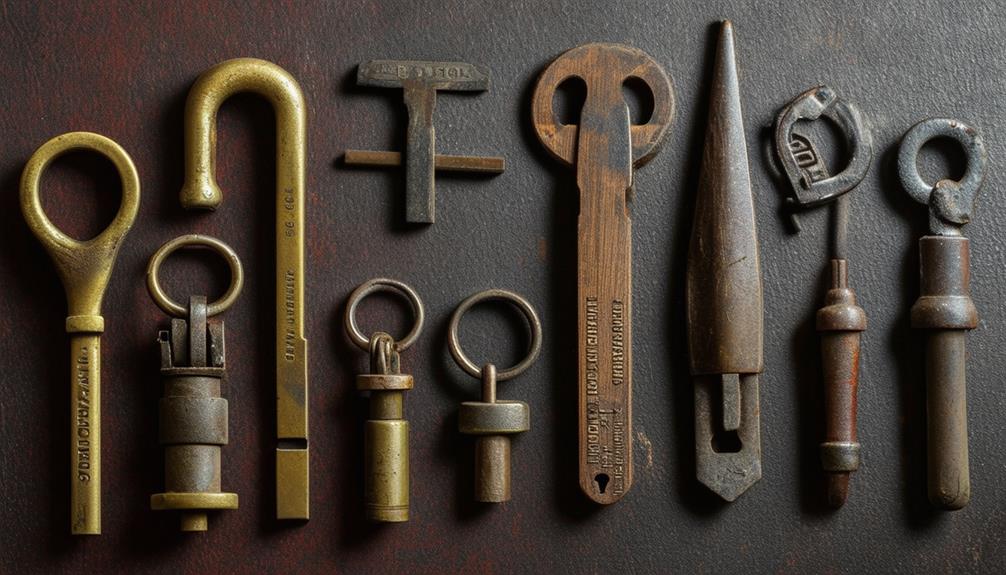
Lock security faced significant challenges during the World Wars as military strategies and espionage heightened the need for advanced locking mechanisms. With the world embroiled in conflict, the demand for secure communication and protection of sensitive information became paramount.
Lock manufacturers were tasked with developing innovative designs to thwart enemy spies and guarantee the safety of classified materials. The evolution of security measures led to the incorporation of more complex designs and materials, reflecting the increasing sophistication of lock technologies.
During World War I, the use of cryptography and encrypted communication surged, leading to a surge in demand for more sophisticated locks. Locks needed to resist picking, bumping, and other covert methods of entry that could compromise essential information.
As the world shifted into World War II, the evolution of lock security continued. Military installations, government buildings, and even everyday households sought heightened protection against potential breaches.
The world wars served as a catalyst for advancements in lock technology, pushing manufacturers to create intricate mechanisms that could withstand the growing threats of infiltration.
The legacy of this era is evident in the intricate locking systems we rely on today to safeguard our belongings and secrets from prying eyes.
Advancements in Lock Technology
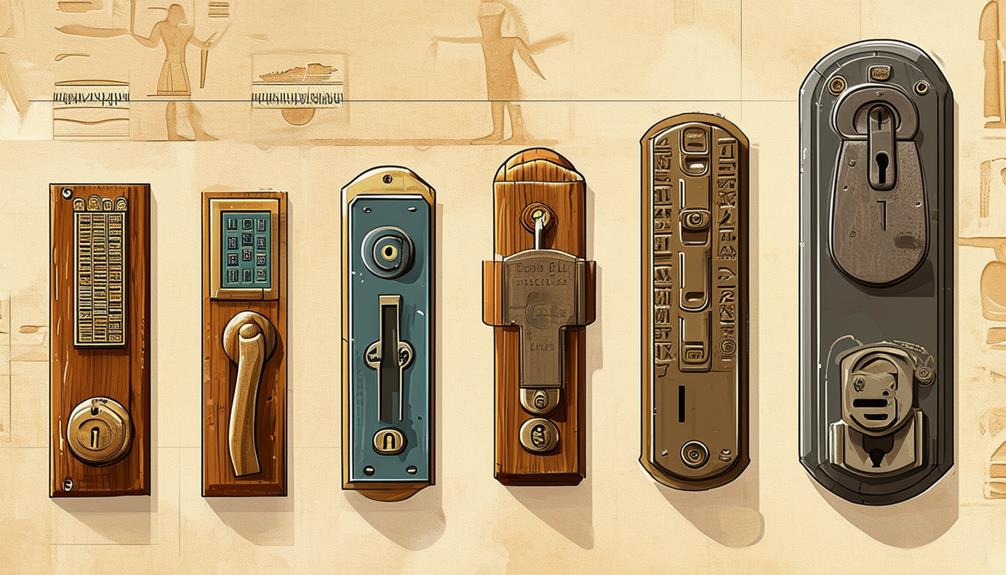
Let's explore the evolution of lock mechanisms and the innovations in security systems that have shaped modern lock technology.
From simple mechanical locks to sophisticated electronic systems, advancements have enhanced the complexity and effectiveness of security measures, including the development of high-security locks that utilize advanced technology and robust materials for enhanced protection.
Understanding these developments is vital in comprehending the challenges faced by locksmiths and security professionals today.
Lock Mechanism Evolution
As lock technology has progressed over time, significant advancements have been made in the evolution of lock mechanisms. One of the key areas where technological advancements in lock picking have driven change is in the development of more complex and sophisticated internal mechanisms within locks.
These mechanisms are designed to enhance security and make it more challenging for unauthorized individuals to bypass the lock. For instance, traditional pin tumbler locks have evolved to incorporate security pins such as spool pins and serrated pins.
These security pins are designed to counter traditional lock picking techniques by creating additional challenges for lock pickers. Additionally, advancements in lock mechanism design have led to the introduction of electronic locks, biometric locks, and smart locks, which offer advanced features like keyless entry, remote access control, and audit trails.
Security System Innovations
With the rapid advancement of technology, security systems have seen remarkable innovations in recent years. These advancements have led to the development of more sophisticated lock mechanisms, making it increasingly challenging for lock pickers to bypass security measures.
The lock picking timeline has been greatly influenced by these security system innovations, as manufacturers endeavor to stay ahead of potential threats.
One major innovation in lock technology is the introduction of electronic locks, which use digital codes or biometric data for access. These locks offer a higher level of security compared to traditional mechanical locks, as they aren't susceptible to traditional lock picking techniques.
Additionally, smart locks that can be controlled remotely via smartphone apps have become increasingly popular for their convenience and enhanced security features.
Furthermore, advancements in materials science have led to the creation of stronger and more durable lock components, making it even more challenging for intruders to manipulate locks.
As security systems continue to evolve, the lock picking timeline will certainly reflect these ongoing innovations in lock technology.
Rise of Lock Sport Communities
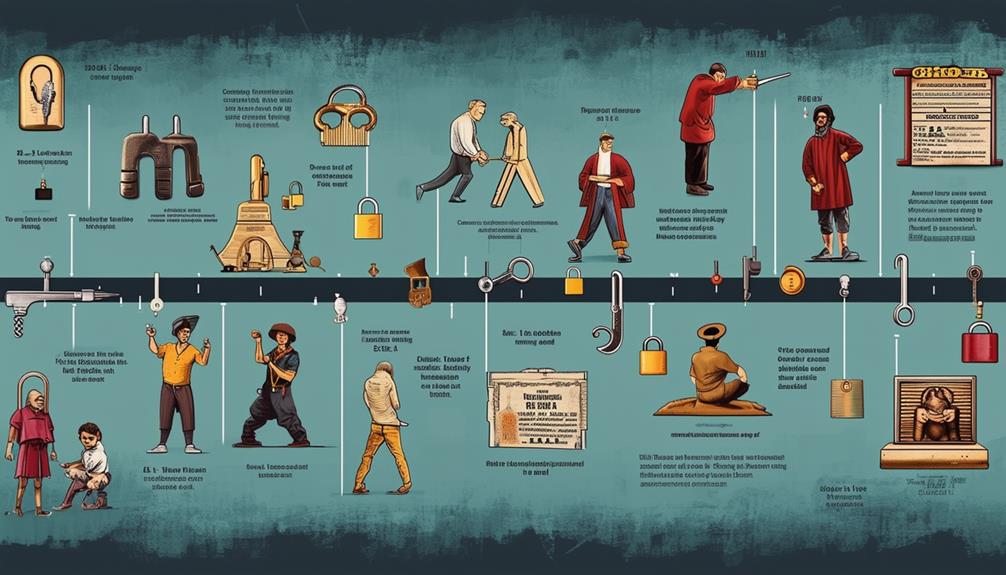
Releasing a new era of interest and camaraderie, the rise of lock sport communities has been a significant development in the domain of lock picking. As lock picking changes over time, these communities have emerged as hubs for enthusiasts to share knowledge, skills, and a passion for the craft.
With rich resources available, such as mastering lock picking techniques, engaging in friendly competitions, workshops, and online forums, members of these communities come together to learn from each other and hone their lock picking abilities.
These communities provide a platform for both beginners and experienced lock pickers to connect, exchange ideas, and explore the evolving techniques in the field. Through in-person meetups and virtual gatherings, individuals with a common interest in locks and security systems can collaborate, challenge each other, and push the boundaries of their skills.
Influence of Cybersecurity on Lock Picking

Lock picking has historically been associated with physical locks and traditional security systems. However, with the advancement of technology and the rise of cybersecurity concerns, the practice of lock picking has evolved to adapt to these changes.
Here are three ways technology has influenced the world of lock picking:
- Digital Lock Systems: The increasing use of digital locks and smart security systems has led lock pickers to develop new techniques and tools to bypass these advanced electronic security measures. As smart locks become more prevalent, understanding their security features and vulnerabilities becomes essential for both security professionals and lock pickers.
- Cybersecurity Awareness: Lock pickers are now more aware of the importance of cybersecurity due to their knowledge of how technology can impact physical security. This awareness has led to a more responsible approach to lock picking techniques and discussions.
- Cross-Disciplinary Learning: The intersection of lock picking and technology has encouraged cross-disciplinary learning, with enthusiasts exploring both physical and digital security concepts to enhance their understanding of modern security systems.
Frequently Asked Questions
How Did Lock Picking Become a Popular Hobby?
Lock picking became a popular hobby because people enjoy the challenge and problem-solving aspects.
It provides a sense of accomplishment when you successfully open a lock. Plus, it's a useful skill to have in certain situations.
As more individuals became interested, the hobby grew in popularity, with communities forming to share tips and tricks.
Are There Any Famous Historical Lock Pickers?
Yes, there are famous historical lock pickers. Notable figures like Harry Houdini and Charles Courtney specialized in lock picking, showcasing their skills and challenging the security of locks.
Their expertise and showmanship captivated audiences and inspired others to explore the art of lock picking.
These individuals contributed to the evolution of lock picking as a skill and a form of entertainment, leaving a lasting impact on the practice.
What Are the Most Challenging Types of Locks to Pick?
When you're trying to pick a lock, the most challenging types are usually high-security locks like Medeco or Abloy.
These locks have unique mechanisms and special features that make them much harder to manipulate. They often have additional pins, false gates, or other anti-picking devices that require advanced skills and specialized tools to overcome.
Is Lock Picking Still a Relevant Skill in Modern Times?
Lock picking remains relevant in modern times for various reasons.
It's a valuable skill for locksmiths, security professionals, and even hobbyists. In emergency situations, like getting locked out, knowing how to pick a lock can be a lifesaver.
However, it's essential to remember that lock picking should only be used ethically and legally.
With the right training and tools, mastering this skill can still be beneficial in today's world.
Can Lock Picking Be Used for Illegal Activities?
Yes, lock picking can be used for illegal activities. While it's primarily associated with security testing and locksmithing, individuals with malicious intent can exploit this skill for unlawful purposes like burglary.
It's essential to emphasize ethical use and legality when learning lock picking. Always make certain you have permission to practice on locks you own or have explicit consent to manipulate.
Misusing this skill can lead to legal consequences and harm others.
Conclusion
Lock picking has come a long way from ancient mechanisms to modern technology. Just like a locksmith carefully selects the right tools to open a lock, you have the power to adapt and overcome challenges using your skills and knowledge. Embrace the evolution of lock picking and see how it parallels your own growth and development. Keep honing your skills, and you'll be revealing new opportunities in no time.

